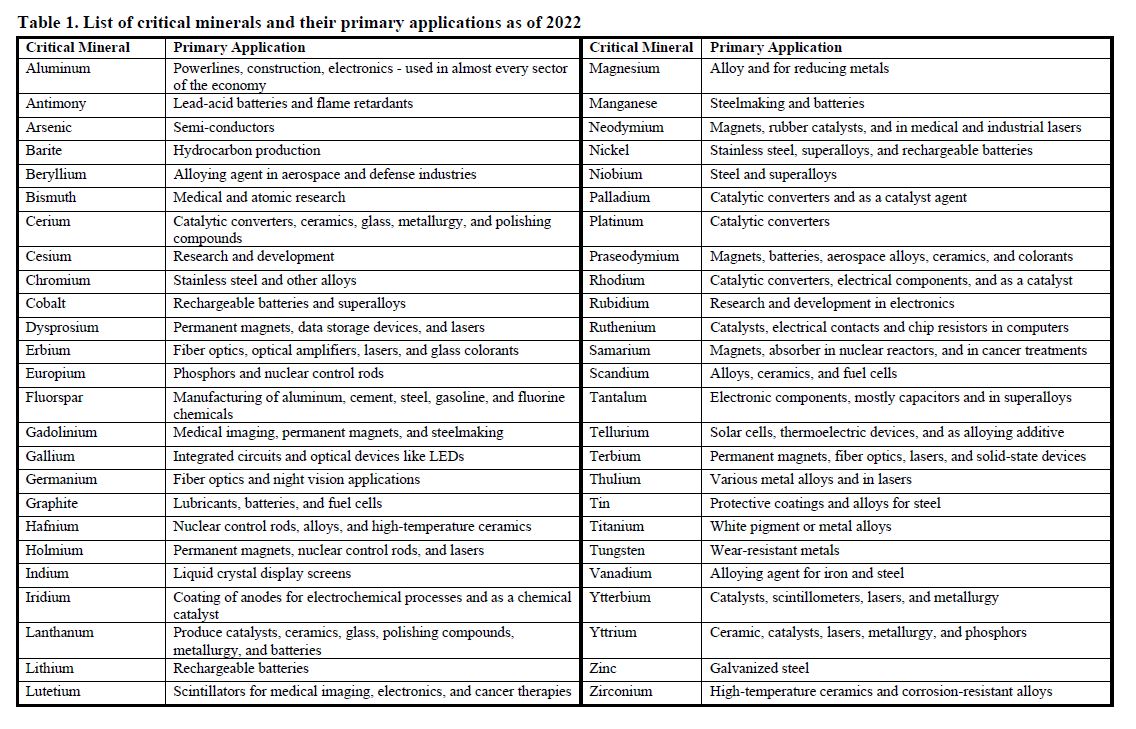Critical Minerals in South Dakota
Project Description
On December 20th, 2017 the White House issued Executive Order 13817, entitled "A Federal Strategy to Ensure Secure and Reliable Supplies of Critical Minerals," citing the reliance of the United States on imports for certain mineral commodities vital to economic and national security interests.
A critical mineral is defined as a non-fuel mineral or mineral material essential to the economic and national security of the United States. Examples of critical minerals are aluminum, chromium, lithium, manganese, nickel, and titanium. In 2022, the United States Geological Survey (USGS) released a list of 50 minerals determined to be critical (Table 1).

Critical minerals are used in cell phones, televisions, computer chips, solar panels, wind turbines, batteries, electric cars, desalination plants, military equipment, and more.
Critical minerals are known to occur in South Dakota; however, none are currently produced primarily because they cannot be mined economically. For example, a relatively large manganese deposit is known to occur in the central and south-central part of the state, but due to the low grade and the deposit being spread over a wide range, it cannot be mined economically. During the 1920's the Etta mine in the southern Black Hills was the principal producer of lithium in the United States. The mine shut down in 1959 because it became unprofitable.
In response to the 2017 Executive Order, several federal agencies implemented programs to provide funding to states to acquire the necessary data needed to aid in mineral exploration.
The United States Geological Survey (USGS) developed the Earth Mapping Resource Initiative (Earth MRI) to identify areas with potential for undiscovered critical mineral deposits. Earth MRI is a collaborative effort between the USGS and State geological surveys to identify, prioritize, and acquire new geoscience data for areas that have potential to host critical mineral resources. Since 2021 the South Dakota Geological Survey (SDGS) has worked with geologists from the USGS and surrounding states to finalize proposals for geophysical surveys to be flown in South Dakota, southwestern Minnesota, northwestern Iowa, northeastern Nebraska, and Wyoming. Three airborne magnetic and radiometric geophysical survey proposals, the Western Spirit Lake Tectonic Zone survey, the Sioux Falls survey, and the Black Hills Bear Lodge survey were chosen to be funded by Earth MRI. In addition, the Cheyenne Belt to Black Hills Airborne Electromagnetic Survey proposal was also chosen to be funded by Earth MRI. As of January 2025, the Western Spirit Lake Tectonic Zone survey has been completed, and the Sioux Falls survey is in progress. The Cheyenne Belt to Black Hills survey and the Black Hills Bear Lodge survey are anticipated to begin in the years 2025 and 2026, respectively.
The Department of Energy (DOE) developed the Carbon Ore Rare Earth - Critical Minerals (CORE-CM) program. This program is specifically looking at coal beds within 13 geologic basins around the United States. One of the projects that was selected by the DOE was the Williston Basin project. The University of North Dakota's Energy & Environmental Research Center (EERC) is heading up the Williston Basin portion of the CORE-CM project.
The EERC petitioned the SDGS to help identify areas in northwestern South Dakota where samples of lignite (coal) could be acquired and subsequently analyzed for rare earth elements (REEs). In October of 2022, the SDGS collected 14 lignite samples from the Cave Hills area in Harding County. Lab analyses indicate that REEs exist in the lignite beds, but at concentrations that would likely make them uneconomical to mine.
A more detailed description of critical minerals can be found here.
